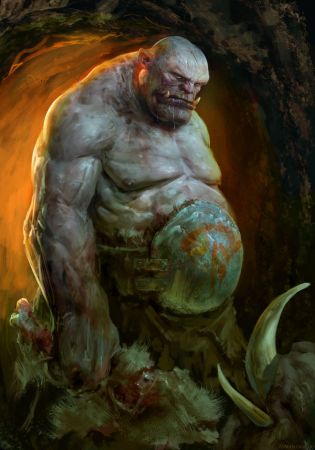Difference between revisions of "Ogre"
Tao alexis (talk | contribs) |
Tao alexis (talk | contribs) |
||
| Line 15: | Line 15: | ||
| hpdie = d10 | | hpdie = d10 | ||
| attack = '''1''': [[Fist (attack)|fist]] or weapon | | attack = '''1''': [[Fist (attack)|fist]] or weapon | ||
| − | | dmg = fist (1-12); [[Weapons List|weapon]] [[Damage (hit points)|damage]] varies | + | | dmg = fist (1-12); [[Weapons List|weapon]] [[Damage (hit points)|damage]]<br>varies |
| special = [[Strength (ability stat)|strength]] 18/00, [[Throw Stones|throw stones]] | | special = [[Strength (ability stat)|strength]] 18/00, [[Throw Stones|throw stones]] | ||
}} | }} | ||
Latest revision as of 22:54, 21 October 2021
| Species | humanoid |
| No. Appearing | 1–8 |
| Behaviour | solitary |
| Range | alpine, desert, steppe, subterranean, woodland |
| Size | 9 ft. tall |
| Weight | 590 lbs. |
| Intelligence | 5 to 6 |
| Armour Class | 5 |
| Hit Dice | 6+1 |
| Action Points | 5 |
| Max. Stride | 12 |
| THAC0 | 17 |
| Hp/Die | d10 |
| Attack Forms | 1: fist or weapon |
| Damage | fist (1-12); weapon damage varies |
| Special Attacks | strength 18/00, throw stones |
Ogres are inhumanly large, tall, hideous-appearing man-like being known to eat ordinary human beings, especially infants and children. The head is disproportionately large, with abundant hair and an uneven, mottled skin, noted for large pockets of fat. Ogres are inordinately strong; they're often presumed to be related to giants, but this is uncertain; tales often use the terms "giant" and "ogre" indiscriminately.
History
Ogres appeared on Earth between eight and ten thousand years ago, apparently in the Eastern Sayan Mountains west of Lake Baykal. Ancient hobgoblin, haruchai and orc scholarship is scanty on their origin, but Sarg Griksta of Yaxjasso wrote that ogre groups appeared intermittently over the centuries as though passing through a planar gate. Exploration deduced the approximately location of the gate, which was never found; it came to be known as the "Orcrest Gate," on account of rare gems coming from the region called "orcrest".
By the Bronze Age, due to their low intelligence, ogres had formed subservient relationships with numerous races, including orcs, haruchai, cavewights and norkers. This has furthered the strength and influence of these empire-building entities, advancing their threat to human and dwarven cultures in Central Asia and Eastern Europe. Multiple invasions and warmongering by these humanoid races have spread ogre populations into many parts of Europe, Arabia and northern parts of Africa.
Behaviour
Ogres are always male and have no female counterpart; they don't reproduce. Solitary ogres adopt a narrow range of activities for long periods. They are often satisfied with eating, resting and amusing themselves by turning or twirling objects, or by letting animals go in order to recapture them. When acting alone, they carry a club as a weapon (1d8 damage); due to their strength, they are +3 to hit and +6 damage with it. Should they drop the club, they'll forget to pick it up, carrying on the fight with their fists. Wounded, an ogre will work itself up to a rage and fight until unconscious or dead, failing to understand when they should run away.
Ogre as Slave
Ogres like to attach themselves to more intelligent humanoid masters, accepting a role as slave to a to a clan or a troop willing to "adopt" the ogre. Ogres prefer orcs, haruchai, cavewights and norkers; when with these groups, the ogre speaks and acts cheerfully as it's given orders. They commonly remain with such groups for decades, so long as the clan or troop survives. They get along less well with goblins, hobgoblins or bugbears. Ogres live for somewhere between 90 and 150 years, though it is rare for one to die of old age.
When with humanoid masters, ogres are given a spear (1d8+1 damage) or godentag (2d6 damage). If the ogre drops this weapon, a humanoid master will urge him to pick it up. This relationship helps the ogre to think more clearly and remain calm in battle. Ogres will also have partial armour, usually a metal plate and helmet, granting it a +2 to +4 armour class.
Ogres are able to throw stones that cause 4-10 damage on a hit (short range, 3-8 hexes; medium 9-14; long 15-20). It will only think to use these in battle, however, when an intelligent humanoid collects the stones and reminds the ogre to make use of them.
See Also,
Ancient History
Bestiary
History
